
Have you heard the horror stories of hobbyists losing everything in a crash after they had began using biopellets? If you’ve spent any time at all on the various hobby forums, I’m positive you’ve read at least one story of woe.
 Those tales are what kept me from attempting to bring my 75 gallon SPS-dominant reef tank into ultra-low nutrient status. I had to come up with something other than what I knew to keep NO3 and PO4 down. Carbon dosing vodka wasn’t acceptable because if I were to come home with a 5th of Smirnoff’s the next purchase I made would be the services of divorce counsel. I couldn’t find enough information on using other forms of sugars to feel comfortable enough to use so that wasn’t an option either.
Those tales are what kept me from attempting to bring my 75 gallon SPS-dominant reef tank into ultra-low nutrient status. I had to come up with something other than what I knew to keep NO3 and PO4 down. Carbon dosing vodka wasn’t acceptable because if I were to come home with a 5th of Smirnoff’s the next purchase I made would be the services of divorce counsel. I couldn’t find enough information on using other forms of sugars to feel comfortable enough to use so that wasn’t an option either.
During MACNA2011 in Des Moines, I was afforded the opportunity to speak with both Dr. Tim Hovanec and Julian Sprung, both of whom market their own variety of bioplastics. I was able to get insight on the proper use of solid carbon to control nitrates and phosphates. Mr. Sprung was very informative and out of the two, it was the talk with him that made me decide to pull the trigger and begin dosing. The fact that I won Two Little Fishies NPX Bio-Plastics and Bactiv8 in the raffle helped the decision along as well. So that is what I did.
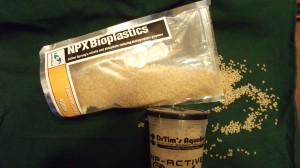 But first I had to understand what a “biopellet” was and how it worked to lower nitrate and phosphate in my system. My layman’s understanding is that the pellets are carbon-based polymers. This organic carbon acts virtually the same as other organic carbons like vodka, sugar, vinegar, etc. only it is in solid, pellet form. The carbon is a food source for aerobic and anaerobic bacteria. These bacteria use nitrates and phosphates to grow and reproduce, so by intentionally feeding them we promote colony growth. A bigger colony means a bigger reduction in NO3 and PO4. By using solid carbon we have provided the bacteria with not only food but a home as well because the pellets are confined inside an appropriate reactor. The use of a reactor and pellets is also a benefit because we can position the outflow of the reactor into the skimmer section of the sump and let the skimmer remove excess bacteria and the slimy, stringy mess they leave behind.
But first I had to understand what a “biopellet” was and how it worked to lower nitrate and phosphate in my system. My layman’s understanding is that the pellets are carbon-based polymers. This organic carbon acts virtually the same as other organic carbons like vodka, sugar, vinegar, etc. only it is in solid, pellet form. The carbon is a food source for aerobic and anaerobic bacteria. These bacteria use nitrates and phosphates to grow and reproduce, so by intentionally feeding them we promote colony growth. A bigger colony means a bigger reduction in NO3 and PO4. By using solid carbon we have provided the bacteria with not only food but a home as well because the pellets are confined inside an appropriate reactor. The use of a reactor and pellets is also a benefit because we can position the outflow of the reactor into the skimmer section of the sump and let the skimmer remove excess bacteria and the slimy, stringy mess they leave behind.
The recommended dosage for the total water volume of my system was 400mL of pellets, which equals about 2.5 cups. Julian had recommended beginning with 1/2 the recommended amount when I started and making adjustments after a couple of weeks. The biggest reason that he recommended this is the fact that as the colony of bacteria grows there are more organisms using oxygen in the water column. This is one of the big dangers of carbon dosing. As more and more oxygen is depleted the livestock that depend on it become endangered. Not only that, but pH is affected by the cellular respiration taking place and it too begins to decline. When it becomes too low, system crash is inevitable.
I began my regimen with 200mL exactly 91 days prior to writing this article. In accordance with the instructions I also began dosing 5mL of Two Little Fishies Bactiv8 NPX per 50 gallons of volume daily for 5 days, bi-monthly afterward. I placed the pellets in a BashSea 4.5″ media chamber. Flow is provided from a Mag12 with a valve manifold. The outflow of the chamber dumps right next to the intake on my EShopps S120 Cone Skimmer.
During the first week to ten days I didn’t notice any change in water clarity, the amount of “dust” that would form on my glass daily, or the annoying brown algae that grew on my back glass and MP40. There were no visible ill effects to my livestock either so I decided that if no apparent changes occurred at the two week mark I would increase the amount of pellets to 300mL.
When the two week mark rolled around I still wasn’t noticing any visible changes. I was still have to wipe the glass clean daily with a MagFloat, etc. I hadn’t been inside the cabinet for a few days and I got a surprise when I opened it. The skimmer was going nuts. I’ve always adjusted it to produce a dry skimmate so that I only need to empty the cup every 4 days or so. On this day the cup was half full of dark, dark effluent and foam production was so intense that what hadn’t dissolved back to fluid form had filled the cup, pushed the cap to the side and was running down the skimmer right back into the water. When I emptied it the smell was so noxious that I actually gagged and walked away from the sink, leaving the tap running so the drain would clear. I’ve since adjusted the skimmer to produce a more wet foam which means I empty the cup more often but the color and smell of the effluent hasn’t changed a bit.
Right around the three week mark I noticed that I wasn’t having to clean the glass as frequently as needed previously. I also noticed that polyp extension on some of my coral wasn’t as good as it had been just the week before. pH was stable at 8.3 and the fish weren’t gasping so I only panicked over low O2 for a second. Because I had read that as the water becomes more crisp, light penetrates better. I simply dimmed the LED’s a bit and with in a couple of hours the polyp extensionwas back to what I am accustomed to seeing. I began to re-acclimate the coral to the intensity of the lighting over my system at 100%.
The next couple of weeks rolled along smoothly. At week 5 I had to add pellets to the reactor and replenish the level back to 200mL. I’m assuming that as the bacterial colony hit maximum density there was a very high demand for food which resulted in almost 100mL of pellets being consumed in such a short time. Since the addition, I’ve not noticed anymore reduction in the volume of pellets tumbling in the chamber. Another observation made during this period was an increase- explosion if you will- of coral skeletal growth and coralline algae. Again I’m only left to assume that this is due to a reduction of PO4 which is an inhibitor to the process corals and coralline use to build with calcium carbonate. At the time I do not own a colorimeter and have to rely on titration testing. When I began dosing solid carbon the PO4 level in my system was somewhere around .2 but possibly slightly higher. I had corals that were browning out even though all of their requirements were met and parameters were stable. At the same time I noticed improved growth, I also noticed improved color in many of my corals. This added to my assumption that phosphate was being knocked down. I retested with a Salifert liquid test and as far as I can tell, the color result tells me the system is at .1 ppm.
Midway through the 7th week the first downfall was noticed. The salt mix I prefer to use is Red Sea Coral Pro. I mix at 35 ppt which results in a KH of around 12. One of the understudied effects of solid carbon dosing is the relationship of alkalinity burn and carbon dosing when the alkalinity levels are kept higher than that of NSW. I’ve read countless stories of alk burn on growth tips when pellets are used but everything I’ve read has been written by hobbyists. There hasn’t been any actual accredited study of this as far as I’m aware. I can say in my case that the faster growing Acropora sp. would grow 1/4″ tips in a week. The flesh would begin to envelop the growth and inexplicably die back. The only fix I could think of was to let the KH fall to 8, do a water change with a new salt (IO Reef Crystals in my case) and maintain the alk at 8. I can not prove that the death of the new tips was alk burn but I can assure you that once I dropped the alkalinity level to one closer to natural sea water and the problem has gone away and new growth is followed by tissue coverage followed by new growth.
At 10 weeks into dosing, the chaeto, caulerpa and mangroves in my refugium began to die back. There just wasn’t the excess nutrients in the system to support the amount of macroalgae I had living in there. No nuisance algae could be found in my DT, and not that much in the sump either for that matter. I was now using the mag float once a week at the most. I’d traded it for a blade to remove the coralline now booming on the glass. No undesirable algae should be a blessing but in reality it only meant that I now have to supplement feeding my algae-eating cleaners.
Sometime during the 11th week I noticed at first what I believed to be slow tissue necrosis on one of my Millepora. Investigating further I noticed zero polyp extension on most of my Gorgonia and a couple had died and lost tissue. In the days following, while I tried to guess what was going on two more SPS began to show skeleton and one Gorg died completely. I had treated the first Acro with a dip in CoralRx and there was no improvement. When I noticed the others showing signs of STN, I also notice that the dead areas were only on the underneath side, the shaded areas of the corals. I believe that by bringing the nutrients down in the system I also robbed corals of food and they were starving. That’s just another assumption but to me it’s plausible because the tissue loss was only in shaded areas. The tissue receiving light could feed from the zooxanthellae contained within, the tissue in the shade required planktonic and/or dissolved food which was no longer available and could not get the energy the coral needed to allow it to live. I increased feeding of phyto and zooplankton, reef chili, coral smoothie and added Elos amino acids to the regimen. I haven’t noticed any signs that the corals are growing new tissue over the exposed skeleton but the areas of living tissue have basically returned to life as usual and no more tissue has been lost.
At the end of twelve weeks I am once again using a MagFloat to clean the dust off the glass almost daily. I’m positive that this is due to the increased feeding of macro foods for the corals. There is no nuisance algae returning and nutrient levels remain low. I empty my skimmer cup daily which is becoming a real pain in the ass. If I had room in the cabinet for a jug I would add a drain line to the cup. My options now as I see them are: 1. to continue on in this way, the system is happy but I’m working my butt off to enjoy it, or 2. Take the pellets off-line and increase maintenance, work my butt off to keep the corals happy and try to enjoy it.
Am I sorry I began dosing with solid carbon? No. Will I continue the regimen? Always. Would I recommend the use of bioplastics? Most definitely. The ups and downs are part of the hobby and a little extra work never killed anyone that I’m aware of.
The aftermath: 91 days+
I became busy with life after completing this article and didn’t get all of the photos taken immediately. The tissue loss of some of my SPS continued while others remained healthy and continued to grow. When my Tort began to show white skeleton I began to get alarmed. pH began a steady decline, the clam began to close up and the fish spent a lot of the day near the surface. Some zoa’s began to die back, others remained normal. I lost a 2″ frag of Jason Fox Meteor Shower overnight.
It wasn’t until my prized Duncan and Euphies began to look wilted that I decided to pull the plug on the pellets. The corals would extend but looked like empty balloons. The Torch was resembling a dying anemone, gaping mouth and all. Even my Lobo which is the size of a Florida orange when puffed up deflated to the size of a plum.
Liquid tests could not detect any NO3 or PO4. The color never changed in either test tube a bit. I believe the water had become t0o clean. I hope someone with the proper equipment does some research into the effects of ULN systems. Because I only know what I saw I can only speculate that truly nutrient free water is no better for our corals than aquariums with excess nutrient issues.
Since I shut the reactor down 3 nights ago the pH in the system has stabilized at 8.3-8.1. The fish have returned to their normal hang-outs. I still believe in the use of bio-plastics. I would just recommend knowing exactly where the levels of nutrients are and determining if pellets are necessary and how much to begin using initially, or if GFO, wetter skimming and increased water changes are all you truly need to control the issue.
Once this system stabilizes I will order another bottle of Bactiv8 and begin dosing solid carbon once again. This time with merely 75-100mL and work my way up from there.

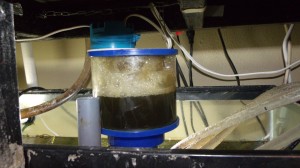
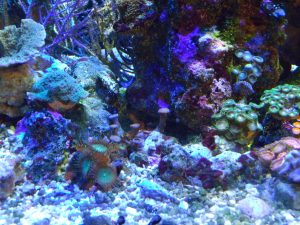
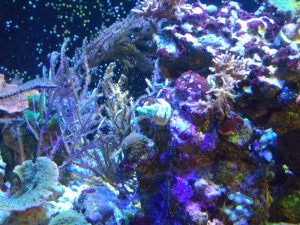
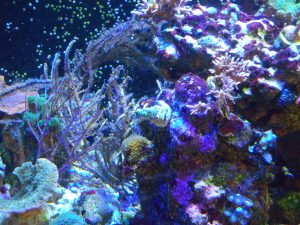
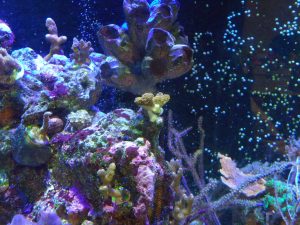
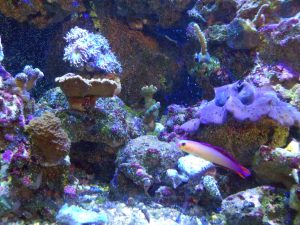
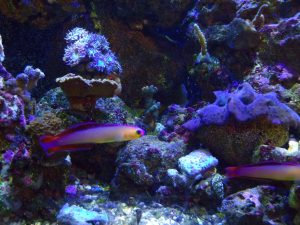
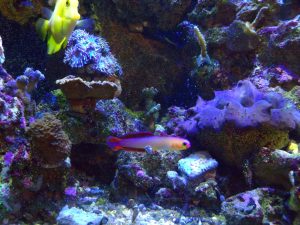
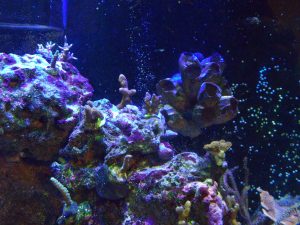








Quite interesting, Michael. I’ve been running them for 10.5 months on my system. I’ve not attributed losses to oxygen deprivation, but have lost a few SPS that shouldn’t have died. I’ve got happy LPS, SPS, Softies, Anemones, Clams and fish, but I’m not seeing 100% success either. I continue to have Macro Algae growth in the refugium and valonia exploding in the frag tank.
I did encounter AEFW in my system about three months ago, so they are getting some of the blame to be sure. I enjoy feeding my tank more heavily without worrying about water quality, but at the same time I’m not sure it is enough to make up for what biopellets/bacteria are taking out.
In January, I’m switching to EcoBak from Warner Marine to see how it works. I’ve run Vertex and Biospheres so far.
I can only assume that it was O2 deprivation from the bacteria and I do so mainly because the fish would spend so much time in the upper levels of the water column, even my Mystery Wrasse spent most of the day cruising just below the surface. pH had also dropped and I couldn’t get it to hold any higher than 7.6. That was a big drop and is possibly the reason for the fish, corals and clam to become stressed but again I feel the drop was due to lack of saturated O2. I wish I’d had tests for oxygen, I’d known for sure then.
Whatever was going on it was definitely a result of the pellets. I’ve seen nothing but improvement in the days since I took it offline. My pH slowly increased back to 8.4-8.3 and has stabilized. Everything is back to normal.
I had a friend in the hobby bring his checkers over two days after shutting the reactor down and even they couldn’t get a reading of nutrients in the water. I’m betting that I never had a valid reason to begin dosing solid to begin with and I’d known that if I’d had checkers myself instead of liquid tests. Especially for PO4.
Would it be interesting to use an aquarium controller with a DO probe and chart the O2 levels? Would this provide some insight as to what is happening in these biopellet trials? I might give this a shot in the near future.
I considered setting the reactor and pellets back up exactly as they were and using a monitor to measure O2 over the course of another 97 day trial. That idea was scrapped when I looked at the price tags. I can’t afford even a PinPoint at this point in life. Liquid tests would be expensive as well, not to mention time consuming and accurate results would be determined only by my ability to perform the test exactly.
I’ve just recently read a thread in which the hobbyist is experiencing tissue loss on some sps in the exact same way my corals lost theirs. This person is using bioplastics though I don’t know for what length of time. Their take on it is overloaded biomass. My opinion on that is the water becomes too clean and the corals are starving to death. Because the tissue loss in every coral in my system and in photo’s of the above mentioned the loss was only in shaded areas of branching SPS.
I believe that SCD is a powerful tool and when used correctly along with a skimmer it’s the best chemical form of excess nutrient control going.(IMHO nothing will ever top a correctly set up DSB, macros and mangroves) It would be nice to see the experts (ie. any company that currently manufactures bio-plastics for the hobby) get together with the hobbyists and a dosage calculator be born from that union.
Ya, those DO probes are spendy (~$500 just for a good probe). I have been wanting to see a real life use for them for a while and this looks like a good one. I already have an Apex to do the data logging, and god knows I never stop having a nutrient problem…hmmm…could I be diligent enough to really make a test out of it…
Your article is great, it helped me understand a lot more… for now, I am using pellets for almost a month now. But I couldn’t notice any changes at all because corals are still bad but fishes are fine and I couldn’t my pH to be higher than 7.8 but my Akl as of right now is at 16.
Well… I don’t care what is about to die or dying… first thing first. I have to get Nitrate under control. First, I used small rocks on the bottoms and I never did gravel cleaning for almost 4 years… everything was perfect. But then my country started to import live sand in a bag. so I bought it and I siphoned my gravel out and replace it with sand. I guess remove gravel was a bad idea… after 1 days, my nitrate spiked to the roof… and so I started pellet but I was using it in a sand chamber for almost a month, it didn’t work too well since it couldn’t move the media around, after 1 month, my nitrate is still as red as blood (according to API test kit)… so I made my own reactor. Just been using it for 2 days now… Will let you know what happened next.
If you don’t mind, perhaps we could chat like a friend… do you have email or other chat account?
But it’s totally fine if you don’t want to share. I was just asking…
And please forgive my english as it’s not my first Language.